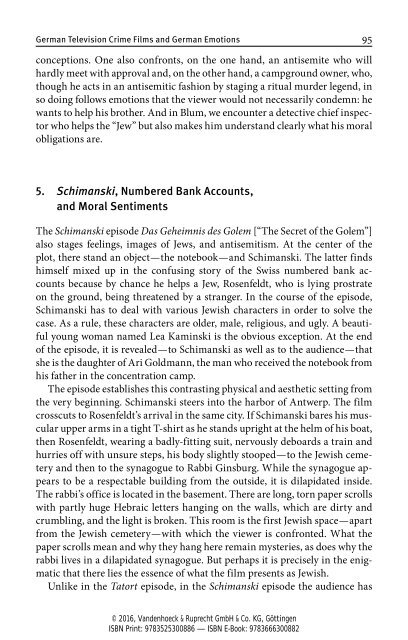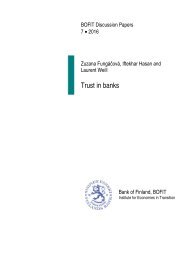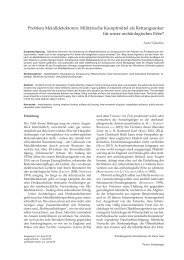Media and Minorities
9783666300882_ruhrmann_media_ebook_034247
9783666300882_ruhrmann_media_ebook_034247
You also want an ePaper? Increase the reach of your titles
YUMPU automatically turns print PDFs into web optimized ePapers that Google loves.
German Television Crime Films <strong>and</strong> German Emotions 95<br />
conceptions. One also confronts, on the one h<strong>and</strong>, an antisemite who will<br />
hardly meet with approval <strong>and</strong>, on the other h<strong>and</strong>, a campground owner, who,<br />
though he acts in an antisemitic fashion by staging a ritual murder legend, in<br />
so doing follows emotions that the viewer would not necessarily condemn: he<br />
wants to help his brother. And in Blum, we encounter a detective chief inspector<br />
who helps the “Jew” but also makes him underst<strong>and</strong> clearly what his moral<br />
obligations are.<br />
5. Schimanski, Numbered Bank Accounts,<br />
<strong>and</strong> Moral Sentiments<br />
The Schimanski episode Das Geheimnis des Golem [“The Secret of the Golem”]<br />
also stages feelings, images of Jews, <strong>and</strong> antisemitism. At the center of the<br />
plot, there st<strong>and</strong> an object — the notebook — <strong>and</strong> Schimanski. The latter finds<br />
himself mixed up in the confusing story of the Swiss numbered bank accounts<br />
because by chance he helps a Jew, Rosenfeldt, who is lying prostrate<br />
on the ground, being threatened by a stranger. In the course of the episode,<br />
Schimanski has to deal with various Jewish characters in order to solve the<br />
case. As a rule, these characters are older, male, religious, <strong>and</strong> ugly. A beautiful<br />
young woman named Lea Kaminski is the obvious exception. At the end<br />
of the episode, it is revealed — to Schimanski as well as to the audience — that<br />
she is the daughter of Ari Goldmann, the man who received the notebook from<br />
his father in the concentration camp.<br />
The episode establishes this contrasting physical <strong>and</strong> aesthetic setting from<br />
the very beginning. Schimanski steers into the harbor of Antwerp. The film<br />
crosscuts to Rosenfeldt’s arrival in the same city. If Schimanski bares his muscular<br />
upper arms in a tight T-shirt as he st<strong>and</strong>s upright at the helm of his boat,<br />
then Rosenfeldt, wearing a badly-fitting suit, nervously deboards a train <strong>and</strong><br />
hurries off with unsure steps, his body slightly stooped — to the Jewish cemetery<br />
<strong>and</strong> then to the synagogue to Rabbi Ginsburg. While the synagogue appears<br />
to be a respectable building from the outside, it is dilapidated inside.<br />
The rabbi’s office is located in the basement. There are long, torn paper scrolls<br />
with partly huge Hebraic letters hanging on the walls, which are dirty <strong>and</strong><br />
crumbling, <strong>and</strong> the light is broken. This room is the first Jewish space — apart<br />
from the Jewish cemetery — with which the viewer is confronted. What the<br />
paper scrolls mean <strong>and</strong> why they hang here remain mysteries, as does why the<br />
rabbi lives in a dilapidated synagogue. But perhaps it is precisely in the enigmatic<br />
that there lies the essence of what the film presents as Jewish.<br />
Unlike in the Tatort episode, in the Schimanski episode the audience has<br />
© 2016, V<strong>and</strong>enhoeck & Ruprecht GmbH & Co. KG, Göttingen<br />
ISBN Print: 9783525300886 — ISBN E-Book: 9783666300882







